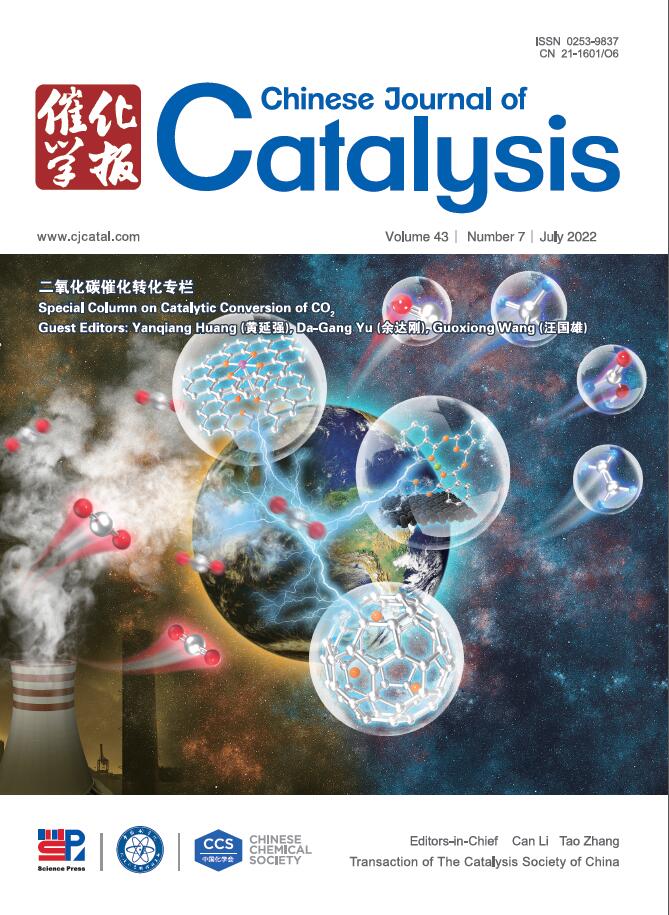Accelerating C-C coupling in alkaline electrochemical CO2 reduction by optimized local water dissociation kinetics
IF 15.7
1区 化学
Q1 CHEMISTRY, APPLIED
引用次数: 0
Abstract
Electrochemical carbon dioxide reduction reaction (CO2RR) produces valuable chemicals by consuming gaseous CO2 as well as protons from the electrolyte. Protons, produced by water dissociation in alkaline electrolyte, are critical for the reaction kinetics which involves multiple proton coupled electron transfer steps. Herein, we demonstrate that the two key steps (CO2-*COOH and *CO-*COH) efficiency can be precisely tuned by introducing proper amount of water dissociation center, i.e., Fe single atoms, locally surrounding the Cu catalysts. In alkaline electrolyte, the Faradaic efficiency (FE) of multi-carbon (C2+) products exhibited a volcano type plot depending on the density of water dissociation center. A maximum FE for C2+ products of 73.2% could be reached on Cu nanoparticles supported on N-doped Carbon nanofibers with moderate Fe single atom sites, at a current density of 300 mA cm–2. Experimental and theoretical calculation results reveal that the Fe sites facilitate water dissociation kinetics, and the locally generated protons contribute significantly to the CO2 activation and *CO protonation process. On the one hand, in-situ attenuated total reflection surface-enhanced infrared absorption spectroscopy (in-situ ATR-SEIRAS) clearly shows that the *COOH intermediate can be observed at a lower potential. This phenomenon fully demonstrates that the optimized local water dissociation kinetics has a unique advantage in guiding the hydrogenation reaction pathway of CO₂ molecules and can effectively reduce the reaction energy barrier. On the other hand, abundant *CO and *COH intermediates create favorable conditions for the asymmetric *CO-*COH coupling, significantly increasing the selectivity of the reaction for C2+ products and providing strong support for the efficient conversion of related reactions to the target products. This work provides a promising strategy for the design of a dual sites catalyst to achieve high FE of C2+ products through the optimized local water dissociation kinetics.
通过优化局部水解离动力学加速碱性电化学CO2还原中的C-C耦合
电化学二氧化碳还原反应(CO2RR)通过消耗气态二氧化碳和电解质中的质子来产生有价值的化学物质。碱性电解液中水解离产生的质子是反应动力学的关键,它涉及多个质子耦合电子转移步骤。在此,我们证明了两个关键步骤(CO2-*COOH和*CO-*COH)效率可以通过在Cu催化剂周围局部引入适量的水解离中心(即Fe单原子)来精确调节。在碱性电解质中,多碳(C2+)产物的法拉第效率(FE)随水解离中心的密度呈火山型曲线。当电流密度为300 mA cm-2时,中等铁单原子位的n掺杂碳纳米纤维负载Cu纳米粒子,C2+产物的最大FE可达73.2%。实验和理论计算结果表明,Fe位点促进了水的解离动力学,并且局部生成的质子对CO2活化和*CO质子化过程有显著贡献。一方面,原位衰减全反射表面增强红外吸收光谱(原位ATR-SEIRAS)清楚地表明,可以在较低的电位下观察到*COOH中间体。这一现象充分说明优化后的局部水解离动力学在指导CO₂分子加氢反应途径方面具有独特优势,并能有效降低反应能垒。另一方面,丰富的*CO和*COH中间体为不对称的*CO-*COH偶联创造了有利条件,显著提高了反应对C2+产物的选择性,为相关反应向目标产物的高效转化提供了有力支持。本研究为设计双位点催化剂提供了一种有希望的策略,通过优化局部水解离动力学来实现C2+产物的高FE。
本文章由计算机程序翻译,如有差异,请以英文原文为准。
求助全文
约1分钟内获得全文
求助全文
来源期刊

Chinese Journal of Catalysis
工程技术-工程:化工
CiteScore
25.80
自引率
10.30%
发文量
235
审稿时长
1.2 months
期刊介绍:
The journal covers a broad scope, encompassing new trends in catalysis for applications in energy production, environmental protection, and the preparation of materials, petroleum chemicals, and fine chemicals. It explores the scientific foundation for preparing and activating catalysts of commercial interest, emphasizing representative models.The focus includes spectroscopic methods for structural characterization, especially in situ techniques, as well as new theoretical methods with practical impact in catalysis and catalytic reactions.The journal delves into the relationship between homogeneous and heterogeneous catalysis and includes theoretical studies on the structure and reactivity of catalysts.Additionally, contributions on photocatalysis, biocatalysis, surface science, and catalysis-related chemical kinetics are welcomed.
 求助内容:
求助内容: 应助结果提醒方式:
应助结果提醒方式:


